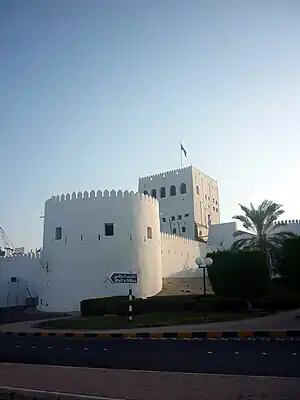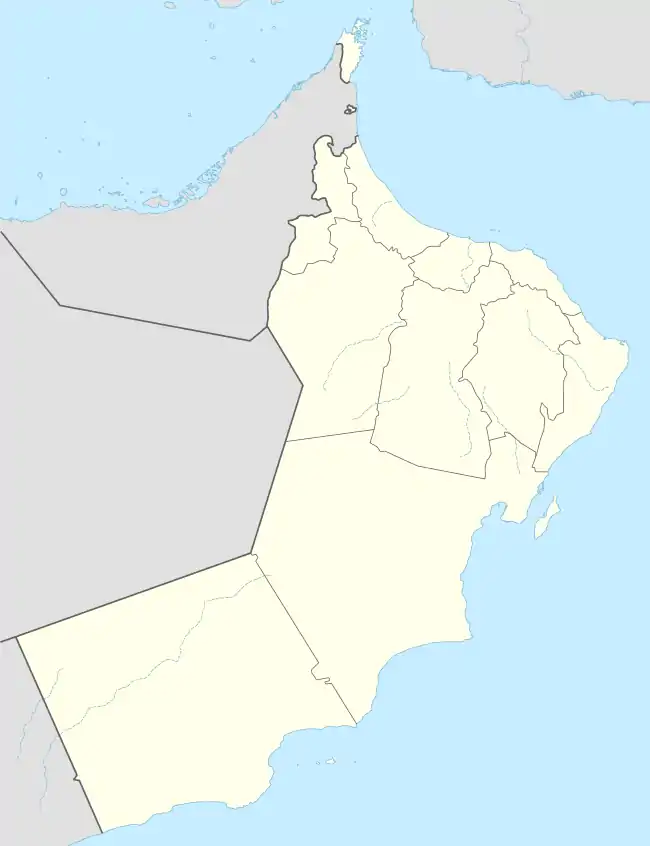Sohar
Sohar (Arabic: صُحَار) is the capital and largest city of the Al Batinah North Governorate in Oman. An ancient capital of the country that once served as an important Islamic port town,[1] Sohar has also been credited as the mythical birthplace of Sinbad the Sailor.[2]
Sohar
صُحَار | |
|---|---|
City | |
 The fort at Al Hujra | |
 Sohar Location in Oman | |
| Coordinates: 24°20′31.2″N 56°43′47.6″E | |
| Country | |
| Governorate | Al Batinah North |
| Elevation | 4 m (13 ft) |
| Population (2016) | |
| • Total | 221,605 |
| Time zone | UTC+4 (Oman Standard Time) |

According to the 2010 census, Sohar's population was 140,006, making it Oman's fifth most-populated settlement.[3] Described as an industrial town,[4] the development of the Sohar Industrial Port during the 2000s has transformed it into a major Omani industrial hub.
History
As the largest town in the region, it has been argued that Sohar is identified with the ancient town called 'Omanah' (Arabic: عُمَانَة) mentioned by Pliny the Elder in his Natural History. This settlement is believed to have given Oman its name.[5]
According to Al-Tabari, in 893 or 894, during the Abbasid era, there was a dispute about who should rule Oman amongst local factions. A faction that approached the Abbasids was the Bani Sama, who were based in Al-Buraimi or Tawam, before moving to Sohar. Bani Sama also referred to themselves as the Wajihid Dynasty, and assumed leadership over the region. The present-day town of Buraimi is part of a historical region that Tabari referred to as 'Tawam', which nowadays also includes the adjacent UAE city of Al Ain.[6]
By the 10th century, Sohar was one of the richest ports of the Persian Gulf. It was praised by Ibn Hawqal and Al-Maqdisi, who called it "flourishing, populous, beautiful, pleasant and delightful" and compared it favourably with the ports of China. Aloes, wood, bamboo, sandalwood and spices were brought from India and frankincense from Dhofar. The city was sacked by the Buwayhids in 971 and its trade went into decline. It also suffered from attacks by the merchants of Kish across the gulf. By the 13th century, it was part of the Kingdom of Hormuz. It was still an international port until at least the 16th century.[7]
Portuguese
In the early 16th century, Sohar was conquered by the Portuguese empire, to control the entrances of the Persian Gulf and trade in the Region. It was part of a web of fortress that the Portuguese had in the region, from Bahrain to Hormuz. It was drawn in the 17th century as it appears in António Bocarro's Book of Fortresses.[8]
Industry
A number of enterprises and investment projects in Sohar are centred around the Port of Sohar. Established in 2002, the port has a strategic importance due to its nearness to the Strait of Hormuz. It is operated by the Sohar Industrial Port Company (SIPC). With current investments exceeding $12 billion, it is one of the world’s largest port development projects. The port's container terminal, managed by Hutchison Ports[9] handles the majority of the container cargo of North Al Batinah region of the Sultanate.
The industrial development of Sohar was prioritised in the Omani Government's economic development plan in 2020. Investments include more than $5 billion in the steel industry in which Oman aims to be one of the Gulf Cooperation Council's leading producers. In addition to the steel industry, there is also the industry of aluminium in Sohar industrial area. The Sohar Aluminium Company was established in 2004[10] and it is considered one of the leading projects that play a major role in the sultanate’s economic diversification strategy.
Education
Sohar has four high educational institutes:
- Sohar University – a private university in association with the University of Queensland.[11]
- Sohar College of Applied Sciences – a government owned college.[12]
- Oman Medical College – a private university in association with West Virginia University School of Medicine.[13]
- International Maritime College Oman.[14]
Suhar also has a number of international schools such as:
- Al Batinah International School (owned by Sohar Aluminium & ORPIC) – only IB SCHOOL.[15]
- Sohar International School (S.I.S)
- Indian School Sohar.[16]
- Pakistan School Sohar
- Bengladesh School Sohar
Climate
Sohar has a hot desert climate (Köppen climate classification BWh) with very hot summers and mild winters. Precipitation is low; more than half of the year's total rainfall falls in February, and summers are almost completely dry.
| Climate data for Sohar | |||||||||||||
|---|---|---|---|---|---|---|---|---|---|---|---|---|---|
| Month | Jan | Feb | Mar | Apr | May | Jun | Jul | Aug | Sep | Oct | Nov | Dec | Year |
| Record high °C (°F) | 32.6 (90.7) |
32.1 (89.8) |
37.4 (99.3) |
44.5 (112.1) |
46.9 (116.4) |
48.5 (119.3) |
50.0 (122.0) |
45.0 (113.0) |
43.2 (109.8) |
42.4 (108.3) |
37.7 (99.9) |
33.9 (93.0) |
50.0 (122.0) |
| Average high °C (°F) | 24.2 (75.6) |
25.3 (77.5) |
27.5 (81.5) |
31.9 (89.4) |
36.3 (97.3) |
36.9 (98.4) |
36.2 (97.2) |
34.7 (94.5) |
34.1 (93.4) |
33.0 (91.4) |
29.5 (85.1) |
26.1 (79.0) |
31.3 (88.4) |
| Daily mean °C (°F) | 18.9 (66.0) |
19.5 (67.1) |
22.4 (72.3) |
26.8 (80.2) |
31.0 (87.8) |
32.7 (90.9) |
33.0 (91.4) |
31.6 (88.9) |
30.3 (86.5) |
27.4 (81.3) |
23.7 (74.7) |
20.4 (68.7) |
26.5 (79.6) |
| Average low °C (°F) | 12.4 (54.3) |
13.3 (55.9) |
16.1 (61.0) |
19.6 (67.3) |
23.7 (74.7) |
26.2 (79.2) |
28.2 (82.8) |
27.1 (80.8) |
24.7 (76.5) |
20.4 (68.7) |
16.8 (62.2) |
14.4 (57.9) |
20.2 (68.4) |
| Record low °C (°F) | 5.7 (42.3) |
5.8 (42.4) |
6.8 (44.2) |
11.2 (52.2) |
16.0 (60.8) |
19.7 (67.5) |
22.4 (72.3) |
21.4 (70.5) |
17.4 (63.3) |
12.0 (53.6) |
8.0 (46.4) |
7.4 (45.3) |
5.7 (42.3) |
| Average precipitation mm (inches) | 4.7 (0.19) |
56.2 (2.21) |
17.0 (0.67) |
7.8 (0.31) |
2.5 (0.10) |
0.0 (0.0) |
0.1 (0.00) |
0.0 (0.0) |
0.5 (0.02) |
0.0 (0.0) |
3.8 (0.15) |
15.9 (0.63) |
108.5 (4.28) |
| Average relative humidity (%) | 72 | 74 | 72 | 65 | 63 | 70 | 77 | 80 | 79 | 73 | 72 | 74 | 73 |
| Mean monthly sunshine hours | 269.4 | 228.6 | 230.8 | 276.0 | 322.4 | 310.9 | 281.5 | 275.6 | 276.3 | 284.6 | 257.5 | 259.8 | 3,273.4 |
| Source 1: NOAA (all but average maximum, 1980–1990)[17] | |||||||||||||
| Source 2: www.world-climates.com (average maximum)[18] | |||||||||||||
Parks
Sohar has four main parks. The first is Sohar Park, located in Al Humbar. The second is the Silver Jubilee Park which is located in Sallan. The third is the Entertainment Park in Sanaiyyah. The fourth is in falaj alqabail. There are many other parks, like Alminyal, Alsanqar, Alsuwaihra, Al Ons, Corniche park and Aluwaynat park. The city also has the Sohar Regional Sports Complex.
Landmarks
- Globe Roundabout
- Sultan Qaboos Grand Mosque Sohar
- Sohar Gate
- Sohar Fort
- Sohar Coastal Market
- Bull Fighting Arena
- Handcrafts Market
- Fish Market
- Sohar Entertainment Center
- Sohar Beach
- Silver Jubilee Park, Sallan
See also
- Al Batinah Region
- List of cities in Oman
- Sohar Airport, the airport which serves the city
References
- Agius, Dionisius A. (2008). Classic Ships of Islam: From Mesopotamia to the Indian Ocean. Brill. p. 85. ISBN 9789004158634. Retrieved 25 June 2014.
- "Tourist Information". Port of Sohar. Retrieved 2011-12-02.
- "timesofoman.com". timesofoman.com. Archived from the original on 2011-07-25. Retrieved 2011-06-12.
- "The sultanate of Oman is taking a kicking". The Economist. 8 July 2017. Retrieved 8 July 2017.
- "Oman". E.J. Brill's First Encyclopaedia of Islam 1913-1936. Encyclopedia of Islam. Leiden: E. J. Brill. 1913. ISBN 9004082654.
- Leech, Nick (2015-10-22). "The long read: has a lost Arab capital been found on the Oman-UAE border?". The National. Retrieved 2019-01-20.
- Dionisius A. Agius, Seafaring in the Arabian Gulf and Oman: People of the Dhow (Routledge, 2005), pp. 76–77.
- Bocarro, António (1635). Livro das plantas de todas as fortalezas, cidades e povoaçoens do Estado da India Oriental.
- "Hutchison Ports". Hutchison Ports. 2014-06-20. Retrieved 2022-04-14.
- "Sohar Aluminum Smelter Project Makes First 'Hot Metal'". www.bechtel.com. Bechtel. Retrieved 15 February 2018.
- "Welcome to Sohar University, Sohar, Sultanate of Oman". Soharuni.edu.om. 2020-05-02. Retrieved 2021-05-25.
- "College of Applied Sciences - Sohar". Jul 30, 2012. Archived from the original on 2012-07-30. Retrieved May 25, 2021.
- "OMC - Introduction". Oct 6, 2007. Archived from the original on 2007-10-06. Retrieved May 25, 2021.
- "Guide To House Rentals". www.imcoman.net. Retrieved May 25, 2021.
- "The Al Batinah International School | A leading IB School in the heart of Oman". abisoman.com. Retrieved May 25, 2021.
- "INDIAN SCHOOL SOHAR". www.indianschoolsohar.com. Retrieved May 25, 2021.
- "Majis Climate Normals 1980–1990". National Oceanic and Atmospheric Administration. Retrieved January 15, 2013.
- "Sohar Climate". www.world-climates.com. Retrieved January 15, 2013.
Further reading
External links
- Omani Ministry of Foreign Affairs
- Overview at Encyclopedia Britannica
